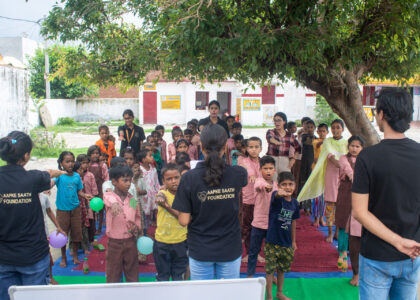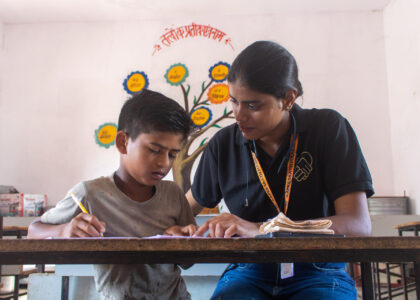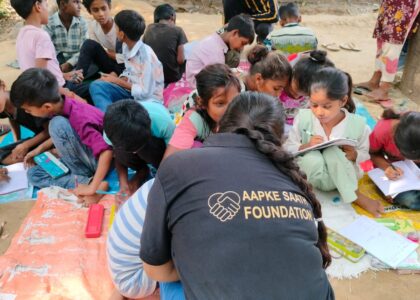Barriers to Girls’ Education in India: Challenges and Solutions

Education is a powerful tool for empowerment and development, yet in India, many girls face significant barriers that hinder their access to and success in school. Addressing these barriers is crucial for achieving educational equity and fostering a more inclusive society. This article explores the main obstacles to girls’ education in India and highlights how the Aapke Saath Foundation is working to overcome these challenges.
Main Barriers to Girls’ Education in India
1. Cultural and Social Norms
Gender Bias and Stereotypes: Traditional beliefs often prioritize boys’ education over girls’. In some communities, education for girls is viewed as less valuable, leading to lower enrollment and retention rates.
Early Marriage: In many regions, early marriage is a common practice, causing girls to leave school and assume domestic responsibilities. This cultural norm significantly impacts girls’ educational attainment.
Caste and Class Discrimination: Girls from marginalized communities face additional barriers due to caste and class-based discrimination, limiting their access to quality education.
2. Economic Constraints
Poverty: Many families struggle with poverty, making it difficult to afford schooling-related expenses such as uniforms, books, and transportation. Economic hardships often lead to prioritizing immediate economic contributions over education.
Opportunity Cost: In impoverished families, the perceived loss of a girl’s potential economic contributions can outweigh the benefits of her education. Girls may be kept out of school to assist with household chores or work.
3. Infrastructure and Accessibility
Lack of Schools: In rural and remote areas, the absence of nearby schools makes it challenging for girls to attend. Long distances and poor infrastructure can deter regular attendance.
Inadequate Facilities: Many schools lack essential facilities, including safe drinking water, proper sanitation, and functional toilets. Inadequate infrastructure can particularly affect girls, impacting their health and attendance.
Transport Issues: Limited or unsafe transportation options can prevent girls from reaching school, especially in regions where travel distances are significant and safety concerns are prevalent.
4. Safety and Security Concerns
Harassment and Violence: Safety concerns, including harassment or violence on the way to or at school, can discourage girls from attending. High crime rates and gender-based violence contribute to these risks.
Lack of Female Teachers: A shortage of female teachers can impact girls’ comfort and willingness to attend school. Cultural norms often require female educators for girls’ education, making this a significant issue.
5. Educational Quality and Relevance
Poor Quality of Education: Many schools face challenges related to educational quality, including a lack of trained teachers, outdated curricula, and insufficient teaching materials. Poor quality can affect girls’ performance and engagement.
Irrelevant Curriculum: Curricula that do not address practical skills or local needs may lead to disengagement. Education that is not relevant to girls’ lives and future prospects can reduce its effectiveness.
6. Legal and Policy Challenges
Implementation Gaps: While policies like the Right to Education (RTE) Act mandate free and compulsory education, gaps in implementation can limit their effectiveness. Awareness and enforcement issues may prevent policies from reaching all intended beneficiaries.
Inconsistent Policies: Variability in policy implementation across different states can create disparities in educational access and quality, exacerbating existing inequalities.
7. Family and Community Attitudes
Parental Education Levels: Parents with low levels of education may not fully understand the benefits of educating their daughters or may lack the resources to support their education.
Community Attitudes: In some communities, entrenched cultural beliefs resist girls’ education. Community leaders and social norms can influence educational priorities and practices.
How Aapke Saath Foundation is Addressing These Barriers
1. Cultural and Social Norms
Awareness Campaigns: The foundation conducts awareness programs to challenge and change societal norms that devalue girls’ education. By educating communities about the importance of girls’ education, they aim to shift cultural attitudes and increase support for female students.
Community Engagement: Collaborating with local leaders and influencers, the foundation promotes the benefits of educating girls and works to address gender biases at the community level.
2. Economic Constraints
Educational Support: Aapke Saath Foundation provides essential educational resources, including uniforms, books, and study materials. This support helps alleviate the financial burden on families and ensures that girls have the tools they need for success in school.
Scholarships and Financial Assistance: The foundation offers scholarships and financial aid to cover education-related expenses, reducing the economic barriers that can prevent girls from attending school.
3. Infrastructure and Accessibility
Infrastructure Development: The foundation works to improve school infrastructure in underserved areas. This includes constructing and renovating school buildings, providing safe drinking water, and installing sanitary facilities to create a conducive learning environment.
Transport Solutions: In regions where transportation is a barrier, the foundation explores solutions such as providing safe transport options or building schools closer to communities.
4. Safety and Security Concerns
Safety Measures: The foundation advocates for and supports initiatives to enhance school safety. This includes implementing measures to protect girls from harassment and violence and ensuring secure transportation options.
Female Teacher Recruitment: Aapke Saath Foundation supports the recruitment and training of female teachers, helping to create a supportive and culturally sensitive educational environment for girls.
5. Educational Quality and Relevance
Quality Improvement Programs: The foundation engages in programs aimed at improving the quality of education, including teacher training and curriculum development. By focusing on educational quality, they ensure that girls receive a meaningful and engaging education.
Relevant Curriculum: Working with local educators, the foundation helps develop curricula that are relevant to girls’ lives and future prospects, ensuring that education is practical and applicable.
6. Legal and Policy Challenges
Policy Advocacy: Aapke Saath Foundation advocates for the effective implementation of education policies and works to address gaps in enforcement. They aim to ensure that policies like the Right to Education (RTE) Act are fully realized and benefit all girls.
Consistent Implementation: The foundation supports efforts to standardize policy implementation across different regions, helping to reduce disparities and ensure equitable access to education.
7. Family and Community Attitudes
Parental Engagement: The foundation involves parents and families in the educational process, educating them about the long-term benefits of girls’ education and providing support to help them prioritize schooling for their daughters.
Community Programs: Through community-based programs, the Aapke Saath Foundation works to shift attitudes and build local support for girls’ education. Engaging with communities helps to create a more supportive environment for female students.
Addressing the barriers to girls’ education in India requires a multifaceted approach, involving cultural change, economic support, infrastructure development, and policy advocacy. Aapke Saath Foundation is making significant strides in overcoming these challenges by implementing targeted initiatives that address the root causes of educational disparities. Through their efforts, the foundation is helping to create a more inclusive and equitable educational landscape, empowering girls to achieve their full potential and contribute to societal development.




